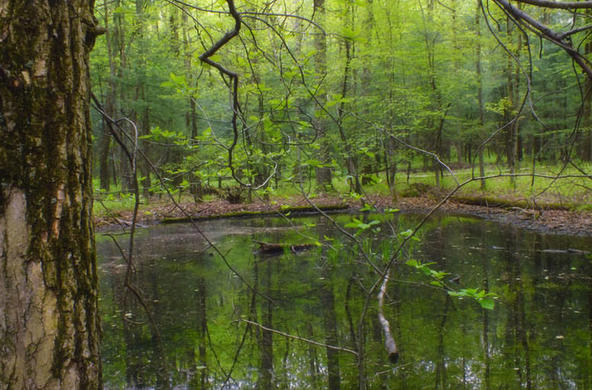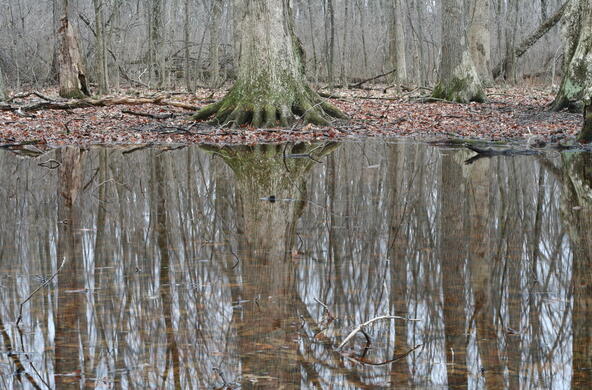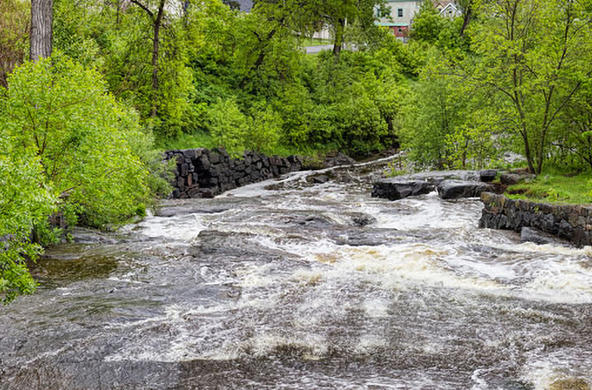What’s for Thanksgiving dinner?
We all have different Thanksgiving favorites. Some people really look forward to that big turkey, some crave sweet potatoes, and I must confess that I head straight for the pies. But today, I want to talk about that old Thanksgiving favorite — wet, rotting leaves.
Thanksgiving, of course, is a harvest festival, when we give thanks for the bounty of growing season that just ended and sample some of that bounty. In our case, that means turkey and potatoes and pumpkin and pies, but for our friends in the stream, it means wet, rotting leaves.
All summer long, the insects and fishes that live in our streams browse on the algae that grow on the stream bottom (that’s the slippery stuff on the rocks that makes it so hard to wade across a stream without falling down) and slurp up the succulent bugs that fall into the stream. But the really big delivery of food to the streams comes in the fall, when falling leaves fall or blow into the water.
Just like your Thanksgiving dinner, these leaves represent the products of the last growing season. They make their way into the stream’s food web in a couple of ways. First, after autumn leaves fall into the water, they release a lot of dissolved organic matter — a sort of leaf tea. You can see this leaf tea as the brown water in leaf-filled puddles on the sidewalk. This tea can amount to more than 10 percent of the weight of the leaf, and is good food for the bacteria and fungi that live in the stream. Stream insects such as mayflies and caddisflies are very happy to feed on these bacteria and fungi.
Stream insects don’t like to eat freshly fallen leaves. Instead, bacteria and especially fungi first colonize the leaves and begin to feed on them. After a few weeks, the unpalatable wet leaves have been transformed into delicious wet, rotting leaves by the fungi (I suppose they must be like little portabello mushroom sandwiches now), and many stream insects start to eat them. This occurs around Thanksgiving each year.
The insects that feed on the wet, rotting leaves are called “shredders,” and include some of the stoneflies and caddisflies, crane fly larvae and crustaceans. When shredders are done with the leaves, they’ve transformed big, rotting leaves into little, rotting leafy bits, which are good food for “collectors” such as many of the caddisflies and mayflies. And of course, all of these stream insects, whether shredders or collectors, feed the trout and other stream fishes that we care about.
The annual leaf-fall is so important to streams that some shredders live only in forested regions and even organize their lives around it. For instance, the winter stoneflies are shredders that become active in the fall, grow fat through the winter feeding on decaying leaves, and emerge onto the snow in late winter. Their eggs hatch into tiny larvae in very early spring, which sleep through the warm summer awaiting the autumnal leaf-fall.
It should be pretty obvious that when we cut streamside trees, we’re depriving the stream of its Thanksgiving dinner. We can also take food away from our friends in the stream when we “clean out” streams by taking out snags and debris, or straighten the stream. The snags and bends in a stream catch and hold leaves, and keep them from washing downstream. When you “clean out” a stream, you starve the ecosystem just as surely as if you cut down the streamside trees.
So now that you understand the importance of wet, rotting leaves to our streams, perhaps you should try serving them to your guests this Thanksgiving. At least, you won’t have to host the family Thanksgiving dinner next year.






